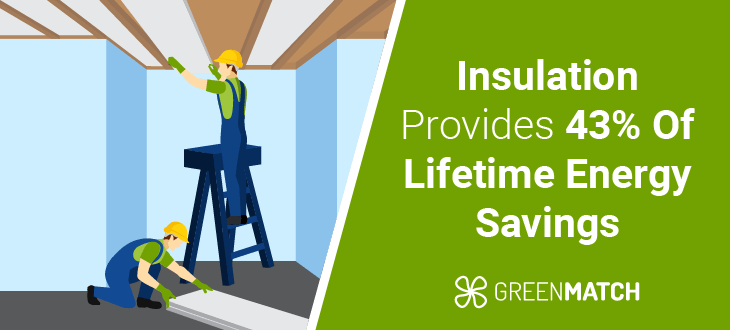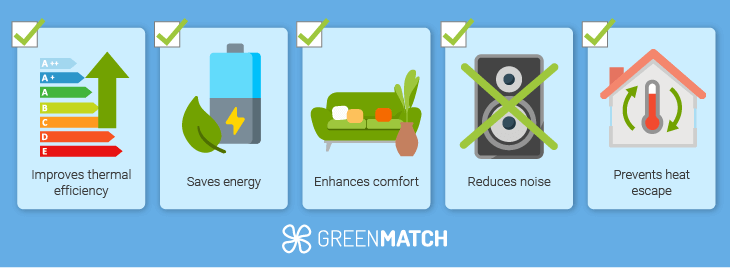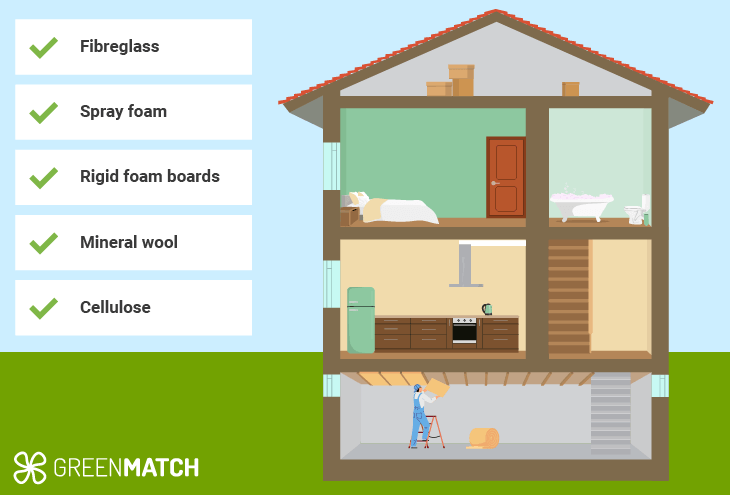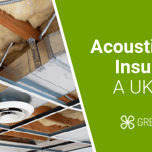Answer these simple questions and we will find you the BEST prices
Which type of solar quotes do you need?
It only takes 30 seconds
100% free with no obligation

Get Free quotes from insulation specialists near you

Save money by comparing quotes and choosing the most competitive offer

The service is 100% free and with no obligation
- GreenMatch
- Insulation
- Basement Insulation
- Basement Ceiling Insulation
Basement Ceiling Insulation: Types, Costs, Pros & Cons


- When selecting insulation for basement ceilings, it's important to balance performance and sustainability.
- Insulation contributes substantially to energy and carbon savings, accounting for 43% of lifetime energy savings.
- In the UK, basement ceiling insulation typically costs £5 to £21.5 per square metre, depending on material, labour, and basement size.
- Insulating a basement ceiling enhances energy efficiency and soundproofing, while also boosting comfort and reducing heating costs.
According to the Household Energy Efficiency report by the UK’s Department for Energy Security and Net Zero (DESNZ), insulation has become more prominent over recent years due to its impact on energy efficiency. While this typically refers to external walls, similar methods can be applied to ceilings in uninsulated spaces like basements.
The report continues to state that solid wall insulation, like basement ceiling insulation, often targets areas that are more expensive and harder to treat, but it yields significant energy savings. Additionally, when it comes to energy and carbon savings, insulation has contributed significantly to energy savings, accounting for 43% of the lifetime energy savings.
When choosing the best type of insulation for basement ceilings, it is important to balance performance with sustainability. This guide will help you learn more about basement ceiling insulation types and their associated costs, ensuring you make an informed decision for your home.
Ready to insulate your basement ceiling? Click the button below, and we’ll connect you with up to 3 free, customised quotes from professional installers in your area. Start now to ensure your basement is properly insulated!
- Describe your needs
- Get free quotes
- Choose the best offer
It only takes 30 seconds



Should you insulate your basement ceiling?

Whether you choose to insulate a basement ceiling or a cellar ceiling depends on your specific needs and the existing condition of your home. Insulating cellar ceilings can be a great solution to reduce heat loss and improve soundproofing.
Insulating your basement ceiling can significantly improve your home's comfort and energy efficiency. Whether it's an older property with a draughty basement or a modern home, deciding to install insulation for cellar ceilings can offer multiple benefits. Still, weighing the pros and cons is crucial to determine if it’s the right solution for your situation.
One of the primary reasons to consider basement ceiling insulation is thermal efficiency. By preventing cold air from rising into your living spaces, you can make your home warmer and reduce your heating bills. This is particularly important in the UK, where winters can be damp and cold. Insulating the ceiling can create a thermal barrier, preventing heat from escaping into unheated basement or cellar areas and ensuring that your living spaces stay cosy.
Adding insulation to your basement ceiling can also improve soundproofing. Sound from the basement can travel upward if your cellar ceiling is beneath frequently used rooms, such as living rooms or bedrooms. Insulating cellar ceilings can help dampen this noise, creating a quieter environment upstairs.
What type of insulation is best for basement ceilings?

When choosing the best insulation materials for your basement ceilings, several factors need to be considered, including thermal efficiency, soundproofing, sustainability, and your home's specific needs. Below, we will delve into the most suitable materials for basement ceiling insulation and their sustainability aspects, making it easier for UK homeowners to decide.
Fibreglass insulation
Fibreglass is one of the most common and cost-effective options for basement ceiling insulation. It comes in batts or rolls, making it easy to install between joists. Fibreglass provides good thermal insulation and soundproofing, particularly useful if your basement is directly beneath a living space. However, it doesn’t offer much protection against draughts unless installed correctly.
- Sustainability: Fibreglass is not considered the most sustainable option. It is made from sand and recycled glass but requires significant energy. While recyclable, it can release microfibers into the air during installation and may not last as long as other materials, contributing to waste over time.
Spray foam insulation
Spray foam insulation is a versatile option for insulating cellar ceilings, especially in older UK homes with uneven surfaces. It seals gaps and cracks, providing high insulation and draught-proofing. Spray foam also has excellent soundproofing capabilities, making it ideal for homes where noise reduction is a priority.
- Sustainability: Spray foam insulation is less sustainable compared to natural materials. It is made from petrochemicals and has a higher environmental impact during manufacturing. Additionally, it is not recyclable and can be challenging to remove, limiting its eco-friendliness.
Rigid foam board
Rigid foam boards, typically made from polystyrene or polyisocyanurate, are highly effective for insulation for cellar ceilings. These boards provide excellent thermal resistance and are easy to install, particularly in newer homes. They also offer good soundproofing qualities.
- Sustainability: Similar to spray foam, rigid foam boards are made from petroleum-based materials, making them less eco-friendly. While some foam boards are now made with environmentally friendly blowing agents, they are still not biodegradable or recyclable. However, their durability means they can last for many years without needing replacement, which can reduce waste over time.
Mineral wool insulation
Mineral wool, also known as rock wool or slag wool, is a dense material that provides excellent thermal and sound insulation. It is ideal for insulating cellar ceilings, especially when soundproofing is a major concern. It’s fire-resistant and water-repellent, which is beneficial for basements prone to dampness.
- Sustainability: Mineral wool is more sustainable than fibreglass and foam-based products. It’s made from natural or recycled materials, such as volcanic rock or industrial waste. Although the production process is energy-intensive, it is a longer-lasting material that can reduce the need for frequent replacements.
Cellulose insulation
Made from recycled paper or plant-based fibres, cellulose is a natural and eco-friendly option for basement ceiling insulation. It’s treated with non-toxic fire retardants, making it a safe choice for homes. While it’s not as commonly used for basements in the UK, it can be blown into tight spaces, providing good coverage.
- Sustainability: Cellulose insulation is highly sustainable, made from recycled materials and has a low environmental impact. It’s biodegradable and requires less energy to produce than synthetic insulation materials. However, it may not be as durable in damp environments, which is a key basement consideration.
How to insulate a basement ceiling
The insulation process can vary depending on the basement insulation you choose and whether you’re doing it yourself or hiring a professional. Here's an overview of the process, including whether a DIY approach is possible and what steps you need to follow.
Is it possible to DIY?
Insulating a cellar ceiling can be a DIY project if you have the right tools, materials, and basic home improvement knowledge. However, it’s important to note that while some insulation materials, such as fibreglass batts or rigid foam boards, are relatively easy to handle, others, like spray foam, may require professional expertise.
DIY installation is more feasible with simple materials, but older or uneven homes, which are common in the UK, may present challenges. Professional installation might be safer if you are dealing with moisture issues or need to seal gaps and draughts.
The process of insulating a basement ceiling

Insulating a basement or cellar ceiling requires careful planning and the right materials to ensure optimal thermal performance and soundproofing. Whether tackling this project or hiring a professional, the steps below outline the essential process to help you achieve effective insulation for ceilings.
- Assess the space: Inspect the basement for any moisture issues before installing. If there are signs of dampness or water intrusion, fixing these problems is crucial before adding insulation to cellar ceilings.
- Choose the right insulation material: The appropriate basement ceiling insulation depends on your goals. For soundproofing, fibreglass batts or mineral wool are effective. Rigid or spray foam boards provide superior performance for thermal insulation, especially for sealing draughts in older properties.
- Gather tools and materials: To insulate your basement ceiling, you'll need key tools and materials, including your chosen insulation material.
- Measure and cut insulation: Measure the spaces between the joists in your cellar ceiling and cut the insulation material to fit snugly.
- Install the insulation: Gently press the material into the spaces between the joists using fibreglass batts or mineral wool. Ensure the insulation fits snugly without being compressed, as compressing the material can reduce its thermal effectiveness. If using rigid foam boards, apply an adhesive to secure them. For spray foam, it’s best to hire a professional as it requires specialised equipment.
- Seal gaps and draughts: Use caulking or spray foam to seal any gaps around the edges of the insulation and along the joists. This will prevent air from leaking through and reduce energy loss.
- Cover the insulation (optional): Sometimes, you may want to cover the insulation with drywall or another finishing material for aesthetic reasons. This step is optional but can improve the appearance of the basement and protect the insulation from wear and tear.
Professional installation
While some materials, like fibreglass batts, can be installed as a DIY project, certain insulation types for basement ceilings are best handled by insulation experts. Spray foam, for instance, requires specialised equipment and expertise to ensure proper application and thorough coverage in tight or irregular spaces.
Similarly, rigid foam boards may need professional installation, especially in older or uneven basements, to guarantee that gaps are properly sealed to prevent air leaks. Suppose you are using mineral wool in a moisture-prone cellar ceiling. In that case, a professional installer can ensure that moisture barriers are applied correctly, helping to avoid long-term issues such as dampness or mould.
Basement ceiling insulation cost in the UK
In the UK, the cost to insulate a cellar ceiling typically ranges between £5 and £21.5 per square metre. This can vary depending on factors such as the type of insulation material, labour costs (if hiring professionals), and the complexity of the installation.
Full insulation for a 50m² basement costs between £250 and £1,075. Below is a table to show the average cost of different materials per m².
| Material | Cost per m² |
|---|---|
| Rigid foam boards (PIR) | £5 - £15 |
| Fibreglass batts | £10 |
| Cellulose insulation | £10 - £12 |
| Mineral wool | £13 - £17.5 |
| Spray foam | £21.5 |
Factors affecting the cost
The price of insulating your cellar ceiling can vary significantly depending on the type of material used, the size of the area, and whether you choose a DIY approach or hire professionals. Below is an overview of the factors affecting insulation prices.
- Material type: The choice of basement ceiling insulation material significantly affects the cost. More affordable options like fibreglass are on the lower end of the scale, while spray foam and rigid foam boards tend to be more expensive.
- Labour costs: If you opt for professional installation, labour costs can significantly increase the overall price. For instance, spray foam requires professional equipment and expertise, making it more expensive than DIY-friendly materials like fibreglass or mineral wool.
- Basement size and complexity: Larger basements, those with irregular surfaces or hard-to-reach areas, will require more material and may involve more complex installations, increasing both material and labour costs.
- Moisture control: If your basement is prone to dampness, you may need to factor in additional costs for moisture barriers or ventilation systems, which are essential to ensure the longevity of the insulation.
Basement ceiling insulation pros and cons
Basement ceiling insulation effectively improves energy efficiency, reduces noise, and creates a more comfortable living environment. However, like any home improvement project, it has advantages and potential drawbacks.
The decision to insulate a cellar ceiling depends on cost, material choice, and whether the benefits, such as increased comfort and reduced heat loss, outweigh concerns like moisture control and installation challenges. Below, we explore the pros and cons to help you make an informed decision.
- Improved energy efficiency: Installing basement ceiling insulation reduces heat loss, helps maintain a warmer home, and lowers heating bills during the colder months, which is particularly important in the UK climate.
- Soundproofing: Insulating cellar ceilings can significantly reduce noise transmission from the basement to the living spaces above, offering a quieter environment.
- Increased comfort: Proper insulation creates a thermal barrier that maintains a more stable indoor temperature, making your home more comfortable).
- Potential increase in home value: Well-insulated homes often have higher energy efficiency ratings, which can attract buyers and increase property value.
- Moisture concerns: Insulating cellar ceilings can trap moisture without proper ventilation, leading to mould growth and damage to the insulation and structural components.
- Cost of professional installation: Certain materials, such as spray foam or rigid foam boards, often require professional installation, adding to the overall cost of the project.
- Limited DIY options: Some materials, like spray foam, are not suitable for DIY installation and require professionals, which can make the process more expensive and less accessible for those looking to cut costs.
- Space considerations: Adding insulation for cellar ceilings can reduce the height of the basement, especially in older homes where space may already be limited.
Compare quotes to get the best deal on your basement ceiling insulation
Getting multiple quotes for your basement ceiling insulation is the easiest way to ensure you make a smart investment. By comparing offers from different professionals, you can spot the best deals and secure quality service that fits your budget.
It’s not just about saving money - it’s about getting the right solution for your home installed by trusted experts.
Now that you know your options, we’re here to help you take the next step! Click the button below to receive up to 3 free, personalised quotes from local professionals. Don’t wait - start today and ensure your basement ceiling is insulated perfectly!
- Describe your needs
- Get free quotes
- Choose the best offer
It only takes 30 seconds



FAQ
The best insulation for basement ceilings depends on your goals. Fibreglass batts and mineral wool are excellent for soundproofing, while spray foam and rigid foam boards offer superior thermal efficiency and draught-proofing.
Choose materials like fibreglass or rigid foam boards to insulate a basement ceiling in the UK. Install between joists, ensuring moisture control and proper sealing to prevent draughts. Professional installation is recommended for spray foam or complex projects.
First, fix moisture issues with a vapour barrier for a damp basement ceiling. Use closed-cell spray foam, which acts as insulation and a moisture barrier. Alternatively, ensure ventilation and install fibreglass or mineral wool with a vapour barrier.
Use spray foam or rigid foam boards to prevent heat loss and seal draughts for a cold cellar ceiling. These materials provide excellent thermal insulation and air sealing. Fibreglass batts are a more affordable option but may not seal as effectively.

Nicole Bea Kerr is a content writer for Greenmatch, leveraging her experience in B2B journalism and editing. She is interested in bringing more awareness to sustainability through informative narratives.
We strive to connect our customers with the right product and supplier. Would you like to be part of GreenMatch?

- Basement Ceiling Insulation: Types, Costs, Pros & Cons
- Should you insulate your basement ceiling?
- What type of insulation is best for basement ceilings?
- How to insulate a basement ceiling
- Basement ceiling insulation cost in the UK
- Basement ceiling insulation pros and cons
- Compare quotes to get the best deal on your basement ceiling insulation
- FAQ

